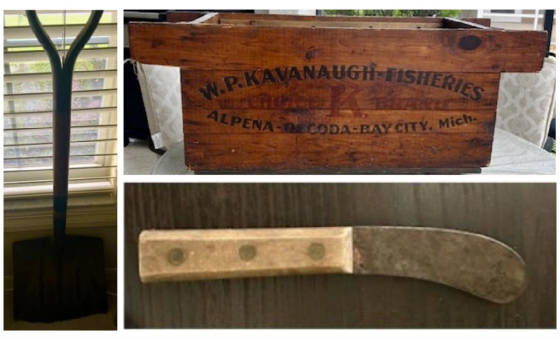THE
FISH BUSINESS
Written and told by Helen Kavanaugh Tobbe (1905-2002) and transcribed
by her youngest child, Kate Tobbe Ptak.
Before starting with Mudi's memories of the fish business and family stories related to it, let's set
the scene.
As many of you know, Bay City is near the mouth of the Saginaw River, which feeds into Saginaw Bay,
which leads into Lake Huron. Point AuGres is on the northern part of the western shore of the bay near the lake. Crossing Saginaw Bay from Bay
City to AuGres was about a three-to-four-hour ride on one of the fish tugs in those times (1915 to 1930). North of Point AuGres are Point lookout, Tawas, Oscoda, Black River, and Alpena. W.P. had fish houses in Oscoda,
Black River, and Alpena as well as Au Gres and Essexville.
WP had one of the largest fish
companies in Michigan at the time.
WP had a big fishery at AuGres. Jr. and I would often ride up to AuGres on one of the fish boats and stay at the fish
house for a few days. Among other entertainments Jr. and I loved to watch the tour
boat unload passengers
up at Point Lookout, which was an elegant resort with beautiful homes on the northern tip of the bay. There was a pleasure boat that took people from Wenona Beach near Bay City to Point Lookout to visit friends in their "cottages"
rather than tour shops, cafes, etc.

Image: Tool & Fish Box. Left:
Shovel for adding ice around the fish. Top right: Fish box used for shipping to New York and other locations.
Top bottom: Fish gutting knife. (In those days the pine wood used for these boxes was very cheap, equivalent to
cardboard we use today for shipping. When a box was emptied it was thrown on a pile for burning.)
It was at AuGres that the fish boats brought the catch in for boxing, then loaded back onto the tugboats to be taken to Essexville to be prepared for loading onto trains
to be shipped east to such places as the Fulton Fish Market in New York City.
The whole operation was on a tight schedule for the fish had to be ready to leave Essexville by 5:00 PM to make the train for New York
A typical
day started with the fishermen going out on the lake
at about 4:00 AM to harvest the fish caught in the nets over the last 24 hours and re-set the nets for the next day's catch. Pound nets or gill nets made of linen and high-grade cotton
were used, which were the strongest, most water worthy nets available in those days. The
fishermen would get back to the AuGres fish house about 7:00 AM. The
fish had to be put on ice in crates to
be shipped to Bay City. The tugs had
to leave AuGres about eleven. They arrived at the
Essexville fish house between 2:00 and 3:00 PM to be re-iced and re-boxed and ready for the 5:00 PM train. The train arrived in New York early the next morning, and the fish were sold at the market that day. I remember at least one occasion when WP had his men block the tracks with their wagons so that the train couldn't leave until all the fish were loaded.
WP built the fish house in AuGres
for his operation. Tons of fish were being boxed and iced there. A Prussian couple named Spaek ran the boarding house
for the fishermen. Mrs. Spaek was the housekeeper and cook. Her husband farmed the land - he was NOT a fisherman. They had their big Thanksgiving feast in early spring, because the operation was closed for the winter. Ice on the lake and bay made fishing in late fall and winter too dangerous.
WP had to cut his own ice and
maintain ice houses for the boxing operations, which kept those men employed who
wanted to work through the winter. Many
of the men didn't. Many of the fishermen were Indians. Often,
many of the Indian
fishermen would go back to their villages and families for the winter.
WP
experimented with a rail car that would be a freshwater tank, so the fish could arrive
in the east still swimming. He was successful in his design, but it was too
expensive to be practical.
One summer, WP decided to create a fishpond up
at AuGres so that he could keep the fish alive and swimming, to be shipped later
in the year when prices were higher. To create the fishpond required blasting. WP wanted to be on site
for this procedure, so prepared to spend most of the summer in AuGres. Nellie and we kids didn't want to
be left alone in Bay City,
so we convinced WP to bring us up to AuGres
for the summer as well. The fish house up there
had rooms for the fishermen, but no extra space for the family, so WP set up tents
for us. Besides the immediate family, Tim Lynch, my second cousin, and Aunt Aggie,
a first cousin of Grandma Callahan was
along. Mosquitoes
finally drove the family out of the tents. If we could keep very quiet so the
fishermen could get their much-needed sleep, the family could stay on the
porch. We tried to honor this deal,
but didn't always succeed.
One hot sticky night, Aunt Aggie set a glass down on a table. Tim Lynch
heard a clinking sound as she set the glass down but couldn't see the contents
of the glass. The clinking sounded like ice cubes, which were reserved for the adults'
drinks, but he was so hot and thirsty that he grabbed the glass to take a big cool drink.
Aunt Aggie spotted him doing this and let out a screech - "My
teeth! Watch my teeth!" There wasn't much quiet that
night after that episode.
When up at the fish camp, Nellie would often take us kids out to pick huckleberries so we could have huckleberry
pie for dessert. Each kid was expected to fill a bucket with berries so there would
be enough good berries for the pie, and
other uses. Huckleberries grew low to
the ground, so we had to crawl around to pick the berries. Margaret didn't like getting hot and dirty picking the berries, so she would fill her bucket with grass and leaves, then pick just enough berries to cover them up.
This is the last blog of Mudie's
Memoirs. Hope you enjoyed her memories of growing up in Bay City. Next month I will start to introduce
W.P. Kavanaugh, starting with a little genealogical information.




